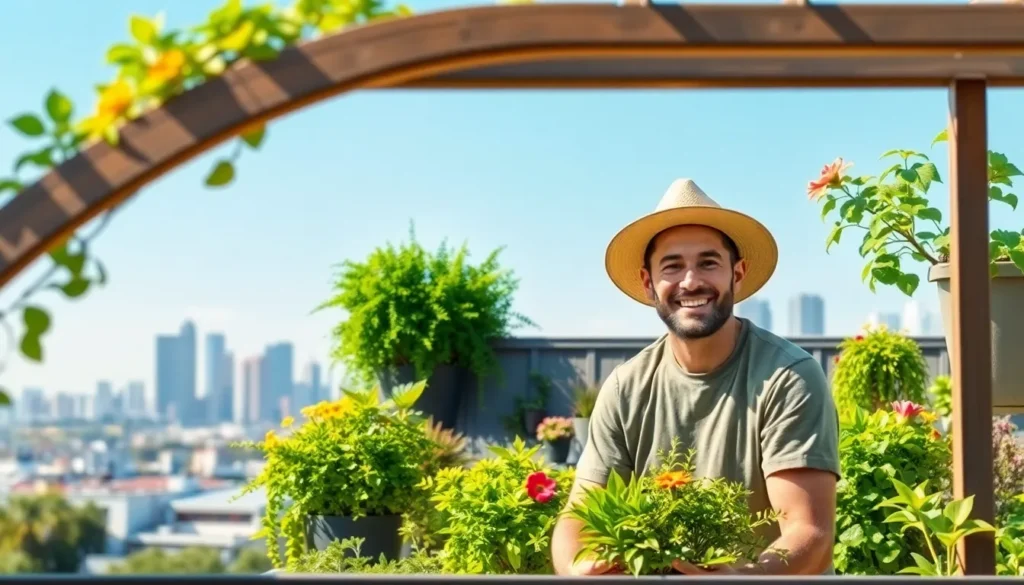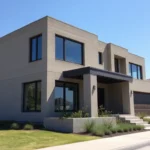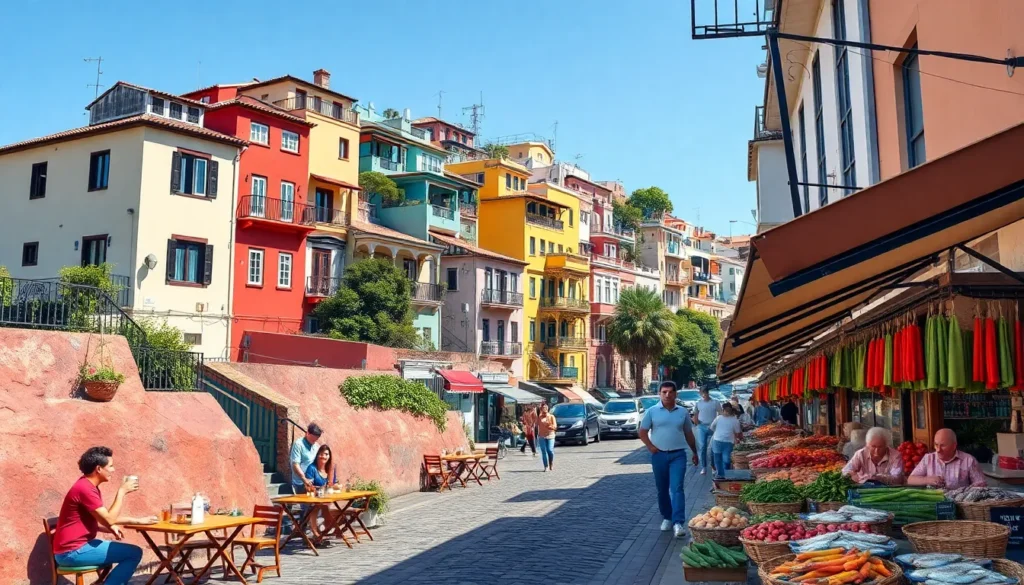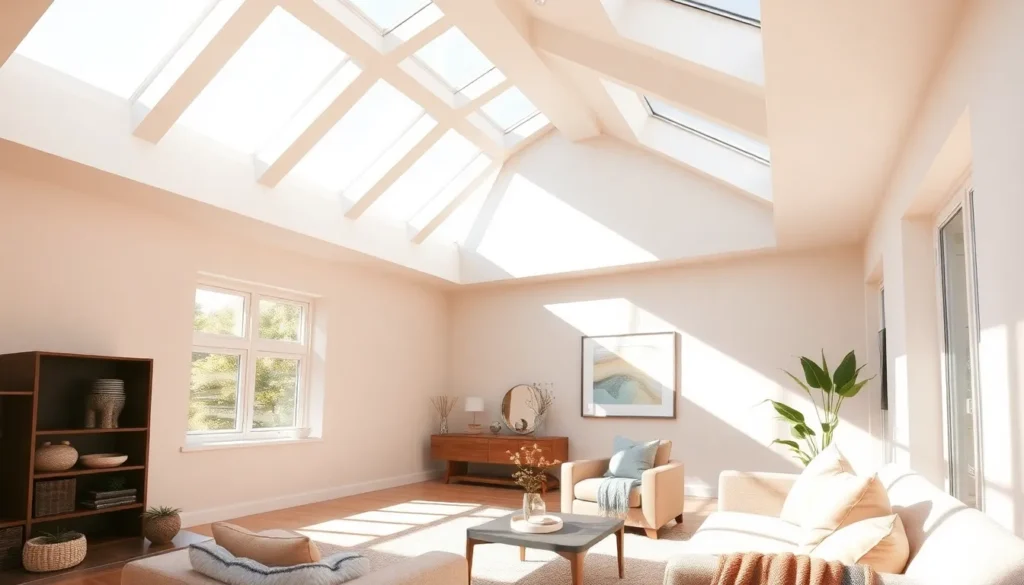Imagine stepping onto your roof and finding a lush garden instead of a barren expanse of shingles. That’s the magic of a green home roof. Not only does it add a touch of nature to urban landscapes, but it also transforms a mundane space into a vibrant ecosystem. Who knew your roof could double as a mini rainforest?
Green roofs aren’t just for the eco-warriors; they offer serious perks like improved insulation, reduced energy bills, and even a cozy retreat for local wildlife. Plus, they’re a conversation starter—“Oh, that? Just my rooftop garden where I grow herbs and contemplate life.” With a green roof, homeowners can embrace sustainability while enjoying a slice of paradise right above their heads. So why not take the plunge and turn that flat roof into a living masterpiece?
Overview Of Green Home Roof
Green home roofs transform standard rooftops into innovative living spaces. These roofs consist of various plant types, which enhance aesthetics and contribute to the environment. Homeowners gain multiple benefits, including improved insulation that maintains comfortable indoor temperatures. Lower energy costs result from the reduced need for heating and cooling systems.
Structural support for green roofs requires careful planning. Weight considerations are crucial, as vegetation, soil, and moisture significantly increase load. Engineers often assess existing roof strength before installation. A variety of materials, such as lightweight soil and drought-resistant plants, can mitigate weight concerns.
Green roofs create habitats for local wildlife, supporting biodiversity in urban settings. Pollinators like bees and butterflies thrive in these lush spaces, contributing to ecosystem health. Birds often visit green roofs, providing additional natural beauty.
Maintenance frequency may vary with plant types and climate conditions. Homeowners must consider irrigation needs, pruning, and pest management. Regular inspections ensure the roof remains healthy and functional. Incorporating native plant species reduces maintenance efforts and promotes resilience.
Aesthetic appeal is another advantage of green roofs. These vibrant designs not only enhance home value but also offer a unique outdoor experience. Abundant greenery provides a serene retreat in bustling urban environments, fostering relaxation.
Green home roofs exemplify sustainable living, blending eco-friendliness with functionality. They offer innovative solutions to urban challenges while encouraging environmental consciousness. Adopting green roofs significantly contributes to the overall well-being of communities and the planet.
Benefits Of Green Home Roof
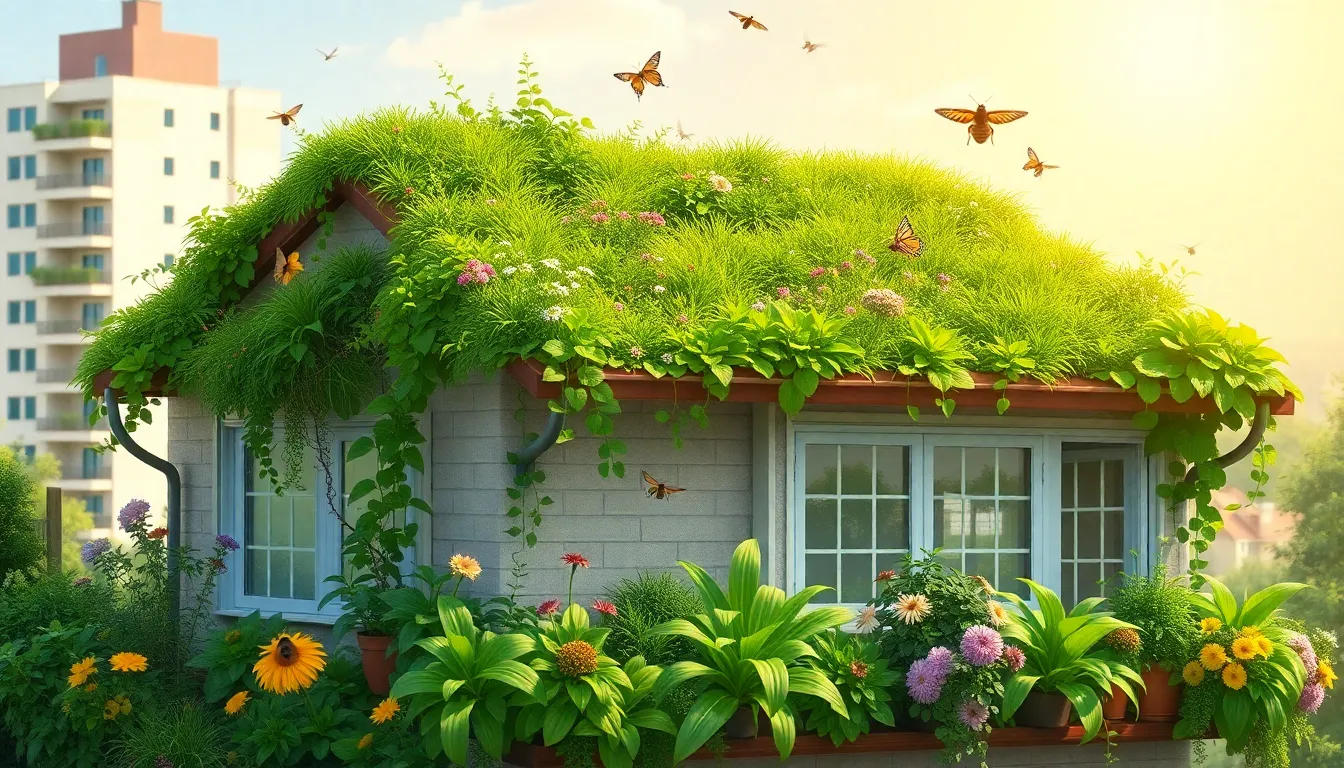
Green home roofs provide numerous advantages, significantly enhancing urban living and environmental conditions.
Environmental Impact
Green roofs play a crucial role in stormwater management. They absorb rainwater, reducing runoff and lowering the risk of flooding. Alongside this, vegetation improves air quality by filtering pollutants and producing oxygen. Wildlife also benefits, as green roofs create habitats for bees, butterflies, and birds. Urban heat islands decrease in size with the introduction of these gardens, leading to cooler temperatures in cities. Biodiversity flourishes in these spaces, supporting various plant and animal species.
Energy Efficiency
Energy savings result from the insulation properties of green roofs. They minimize heat loss in winter and reduce heat gain in summer. Studies show that homes with green roofs experience lower energy costs, as heating and cooling demands decrease. Significant reductions in energy consumption contribute to lower greenhouse gas emissions. Enhanced roof insulation also prolongs the life of roofing materials, reducing the need for replacements. Homeowners enjoy comfort throughout the year without relying excessively on HVAC systems.
Aesthetic Value
Aesthetic appeal increases for homes with green roofs. Lush greenery transforms otherwise dull rooftops into vibrant, living spaces. This enhancement provides a serene retreat for residents while improving neighborhood charm. Property values often rise, as homebuyers appreciate eco-friendly features. Additionally, creating green roofs fosters opportunities for urban gardening and recreational spaces. These gardens invite relaxation and contribute positively to mental well-being.
Types Of Green Home Roofs
Green home roofs come in various types, each offering unique benefits and applications that suit different homeowner needs and urban environments.
Intensive Green Roofs
Intensive green roofs consist of deep soil layers, ranging from 8 to 24 inches, accommodating a wide array of plants, including shrubs and trees. Maintenance requirements for these roofs are higher, necessitating regular irrigation and care. They provide significant biodiversity enhancements, attracting diverse pollinators and wildlife. Due to their structural demands, intensive systems often require professional installation. They work well for creating rooftop gardens or recreational spaces. Homeowners enjoy greater flexibility in plant selection, allowing for a more personalized aesthetic experience.
Extensive Green Roofs
Extensive green roofs feature shallow soil profiles, typically ranging from 2 to 6 inches, supporting hardy, low-maintenance plants like sedums and grasses. Their lightweight design requires less structural reinforcement, making them easier to install on existing roofs. Many homeowners appreciate the lower upkeep associated with extensive systems, as they are drought-resistant and need minimal irrigation. Enhanced stormwater management occurs with these roofs, as they absorb rainwater effectively. Costs tend to be lower for installation and maintenance, making extensive options more accessible for homeowners seeking eco-friendly solutions.
Installation Considerations
Installing a green home roof requires careful planning and adherence to specific guidelines. Factors like structural integrity and maintenance must be thoughtfully addressed.
Structural Requirements
Structural requirements play a crucial role in the installation of green roofs. Assessing existing roof strength is essential since the added weight from vegetation, soil, and moisture impacts load distribution. Engineers often conduct thorough evaluations to confirm that the building can support the roof’s design. Intensive green roofs necessitate deeper soil layers, leading to significant structural demands. Extensive varieties, with shallower soil profiles, usually present lower reinforcement needs but still require professional assessment. Proper reinforcement ensures longevity and safety, allowing homeowners to enjoy their green roofs without concern.
Maintenance Needs
Maintenance needs vary significantly between intensive and extensive green roofs. Intensive green roofs, while beautiful, demand regular upkeep like irrigation, pruning, and pest management due to the diversity of plant life. Extensive roofs, in contrast, generally require less attention as they often feature hardy, drought-resistant plants. Homeowners should monitor irrigation requirements, especially in dry climates. Seasonal care, including weeding and checking for pests, remains essential for all green roofs. Choosing native plants can further reduce maintenance efforts, enhancing the sustainability of the installation. Maintaining a green roof contributes to its overall health and aesthetic appeal.
Cost Analysis
Investing in a green roof involves careful consideration of both initial costs and long-term savings. Understanding these financial aspects can guide decision-making for homeowners.
Initial Investment
Costs for installing a green roof vary based on factors like roof type, plant selection, and design complexity. Generally, intensive green roofs incur higher expenses due to the need for deeper soil and specialized plants. On average, homeowners spend between $10 to $25 per square foot for intensive systems. Extensive green roofs, however, range from $5 to $15 per square foot, making them a more budget-friendly option. Structural assessments also add to initial expenses, especially if reinforcement is necessary. Professional installation is common for both types, increasing upfront costs but ensuring proper setup.
Long-Term Savings
Long-term financial benefits become apparent with green roofs. Homeowners experience reduced energy bills due to improved insulation, translating into yearly savings of 20 to 40 percent. Additionally, they can lower reliance on heating and cooling systems, enhancing energy efficiency. Stormwater management further decreases costs associated with water drainage and municipal fees. Studies show that green roofs can mitigate runoff by up to 80 percent, reducing flood risks and associated damages. Property values commonly increase as well, making green roofs a worthwhile investment for future resale.
Green home roofs represent a significant step toward sustainable living in urban environments. By transforming traditional rooftops into vibrant green spaces, they not only enhance aesthetic appeal but also offer numerous environmental benefits. The ability to improve insulation and reduce energy costs makes them a smart investment for homeowners.
Moreover, green roofs contribute to biodiversity and support local wildlife, creating a harmonious balance between nature and urban life. With careful planning and maintenance, homeowners can enjoy the advantages of these eco-friendly roofs while positively impacting their communities. Embracing green roofs is more than just a trend; it’s a commitment to fostering a healthier planet for future generations.

